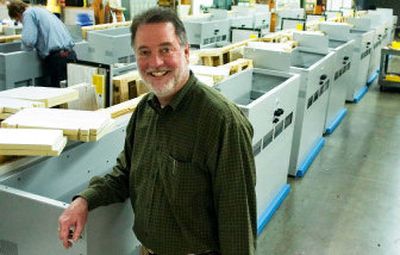Back from the brink

When a company shrinks from 250 workers to 50 two years later, some lessons remain firmly in mind.
Harold Alexander, CEO of Logan Industries Inc., says the key lesson learned by the Spokane Valley contract manufacturer was the need to diversify its customers.
Logan Industries doubled its workers between 1999 and 2000, keeping two shifts busy pumping out components and specialized electronic cables for customers around the world.
But by late 2001 those customers — mostly in the telecommunications industry — bailed out of the market, with a large number flaming out in the tech meltdown that lasted until 2003.
Three years later Logan Industries, using leased space inside the Spokane Business and Industrial Park, has developed a wider range of customers than it had five years ago.
“We expect to double our business in 2006 (compared with 2005),” Alexander said.
Logan’s customers now include ReliON Inc., the former Avista division that makes hydrogen fuel cells; Seattle Aero, an aerospace integrator that works with Boeing and other major aviation firms; and Northern Technologies Inc., the Liberty Lake producer of backup power cabinets for radio towers.
“It’s been a bumpy road. But we’re doing better, by focusing on new customers and our core competence,” Alexander said. Logan currently employs about 70.
Spun out as a separate company from Liberty Lake-based Telect in 1999, Logan Industries rode the telecom boom in 2000 by producing cable harnesses for electronics firms including Agilent Technologies.
Cable harnesses — the shielded wires and connectors that link together electronic components — vary in size and complexity, depending on their purpose. But since 2001, the production of most cable harnesses has moved offshore.
Alexander and the Logan team realized they could survive by taking on the next step in the contract manufacturing process — assembling components into finished products and shipping them to customers.
Since last fall, the company’s best, most complex example has been assembling a component used by Boeing in its high-end Connexion by Boeing communications system for airplanes.
Connexion by Boeing, used so far only by a handful of international airlines, allows passengers Internet connections through orbiting communications satellites.
Seattle Aero, a company that has used Logan on a few occasions, subcontracted with Logan Industries last fall to assemble one of the electronics boxes that fit inside the nose of an aircraft using the Connexion by Boeing service.
Each box involves an array of circuit boards, electronic subcomponents and hundreds of specialized cables. Alexander said it takes several Logan workers about two weeks to assemble each box.
Tackling a project of that size, in an industry where Logan had no prior experience, was a challenge, said Alexander.
“When you talk about the level of attention you need for aerospace products, this is very specialized work for us,” he said.
“It takes a lot of management time. It’s very time-consuming and can be very difficult when you get first involved in it,” he added.
Contract manufacturers across the United States are coping with the same tactic; they take on additional services they didn’t offer before, said Herb Jones, Logan’s vice president of business development.
“You have to stay up with the technology and constantly learn from your customers,” Jones said.
Boeing has helped Logan overcome the steep learning curve of working with aerospace companies, Alexander said. That relationship with Boeing, he added, might lead to more jobs in the aerospace industry.
But Alexander is careful about thinking too far ahead.
Burned once before — and having completed a Chapter 11 reorganization in 2002 to keep Logan Industries in business — Alexander doesn’t want to get too confident.
“I’m almost afraid to see our name in the paper. It’s like I’m asking for something bad to happen to Logan Industries.”